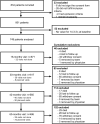Impending radiographic erosive progression over the following year in a cohort of consecutive patients with inflammatory polyarthritis: prediction by serum biomarkers
- PMID: 32371434
- PMCID: PMC7299510
- DOI: 10.1136/rmdopen-2020-001191
Impending radiographic erosive progression over the following year in a cohort of consecutive patients with inflammatory polyarthritis: prediction by serum biomarkers
Abstract
Background/purpose: To evaluate biomarkers as predictors of impending erosion progression.
Methods: Variables were measured at baseline and annually up to 5 years in patients with recent-onset polyarthritis treated to zero swollen joints. Erosive status was defined as ≥5 Units in Sharp/van der Heijde Erosion Score; Rapid Erosive Progression (REP) was defined as an increase ≥5 Units in Erosion Scores between consecutive visits. Generalised estimating equations (GEEs) evaluated the effect on REP of positive anticyclic citrullinated peptides (ACPAs) and/or rheumatoid factor (RF), C-reactive protein ˃8.0 mg/L (High-CRP) and 14-3-3η protein ≥0.50 ng/mL (High-14-3-3η), alone and in combinations.
Results: Out of 2155 evaluations in 749 consecutive patients, REP occurred after 186 (8.6%) visits, including 13 (2.2%) in patients recruited since 2010. Only 18/537 (3.4%; 6/411 (1.5%) in non-erosive vs 12/126 (9.5%) in patients already erosive) visits without any positive biomarker were followed by REP; at least one biomarker was positive prior to REP in 168/186 (90.3%) visits. Being positive for all four biomarkers conferred a positive predictive value (PPV) of 30.0% (RR 21.8) in patients non-erosive at the visit versus 35.5% (RR 3.07) in those already erosive. High-14-3-3η increased REP only in visits with High-CRP (eg, RR 2.5 to 3.9 when ACPA also positive) and in patients with non-erosive status (eg, RR from 4.3 to 9.4 when also High-CRP).
Conclusions: Adding High-14-3-3η to positive antibodies and CRP improves prediction of impending REP. Although REP is becoming rarer, signatures of biomarkers might help to adapt treatment strategies in at-risk individuals, even those already erosive.
Keywords: 14-3-3η; Anti-CCP2 antibodies; CRP; Radiographic progression; Recent-onset inflammatory arthritis; Rheumatoid factor.
© Author(s) (or their employer(s)) 2020. Re-use permitted under CC BY. Published by BMJ.
Conflict of interest statement
Competing interests: Norma Biln is an Augurex Life Sciences Inc employee. None of the other authors reports any conflict of interest related to this manuscript, except that the 14-3-3η measurements were performed free of charge by Augurex Life Sciences Inc, Augurex remaining totally blinded to clinical data.
Figures

Similar articles
-
Serum levels of 14-3-3η protein supplement C-reactive protein and rheumatoid arthritis-associated antibodies to predict clinical and radiographic outcomes in a prospective cohort of patients with recent-onset inflammatory polyarthritis.Arthritis Res Ther. 2016 Feb 1;18:37. doi: 10.1186/s13075-016-0935-z. Arthritis Res Ther. 2016. PMID: 26832367 Free PMC article. Clinical Trial.
-
14-3-3η is a novel mediator associated with the pathogenesis of rheumatoid arthritis and joint damage.Arthritis Res Ther. 2014 Apr 21;16(2):R99. doi: 10.1186/ar4547. Arthritis Res Ther. 2014. PMID: 24751211 Free PMC article.
-
A prospective cohort study of 14-3-3η in ACPA and/or RF-positive patients with arthralgia.Arthritis Res Ther. 2016 Apr 1;18:76. doi: 10.1186/s13075-016-0975-4. Arthritis Res Ther. 2016. PMID: 27037016 Free PMC article.
-
14-3-3η: a novel biomarker platform for rheumatoid arthritis.Clin Exp Rheumatol. 2014 Sep-Oct;32(5 Suppl 85):S-35-9. Epub 2014 Oct 30. Clin Exp Rheumatol. 2014. PMID: 25365087 Review.
-
14-3-3η protein: a promising biomarker for rheumatoid arthritis.Biomark Med. 2018 Aug;12(8):917-925. doi: 10.2217/bmm-2017-0385. Epub 2018 Jul 19. Biomark Med. 2018. PMID: 30022679 Review.
Cited by
-
Validation of the Coping with Health Injuries and Problems questionnaire in a longitudinal cohort with recent-onset RA.Rheumatol Adv Pract. 2025 May 22;9(3):rkaf057. doi: 10.1093/rap/rkaf057. eCollection 2025. Rheumatol Adv Pract. 2025. PMID: 40686915 Free PMC article.
-
Osteoclast microRNA Profiling in Rheumatoid Arthritis to Capture the Erosive Factor.JBMR Plus. 2023 Jun 5;7(8):e10776. doi: 10.1002/jbm4.10776. eCollection 2023 Aug. JBMR Plus. 2023. PMID: 37614303 Free PMC article.
-
Differences in referral path, clinical and radiographic outcomes between seronegative and seropositive rheumatoid arthritis Mexican Mestizo patients: A cohort study.PLoS One. 2024 Jun 6;19(6):e0304953. doi: 10.1371/journal.pone.0304953. eCollection 2024. PLoS One. 2024. PMID: 38843126 Free PMC article.
References
Publication types
MeSH terms
Substances
Grants and funding
LinkOut - more resources
Full Text Sources
Medical
Research Materials
Miscellaneous
